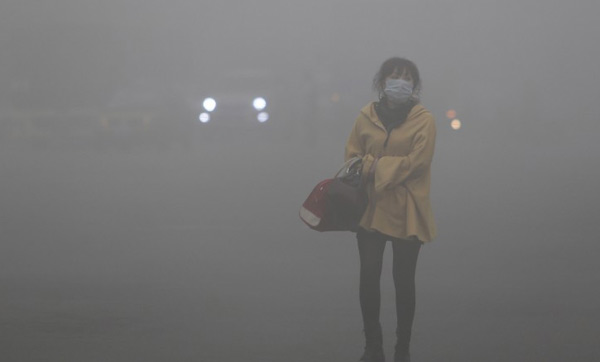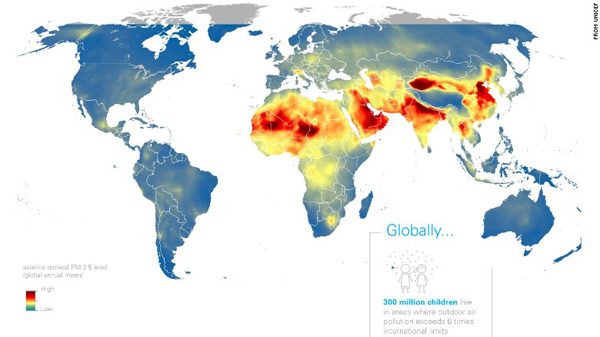當(dāng)前位置: Language Tips> 雙語新聞
UNICEF: Air pollution kills 600,000 children yearly
分享到
或許是長年在霧都生活,很多人對(duì)霧霾已漸漸變得麻木。面對(duì)一個(gè)接一個(gè)的霧霾天,民眾也不再吐槽,只是氣定神閑地“等風(fēng)來”,把霧霾的種種危害拋之腦后。然而,事實(shí)真相是,霧霾正對(duì)人類尤其是兒童的健康產(chǎn)生致命的傷害。聯(lián)合國兒童基金會(huì)的新報(bào)告指出,每年有60萬名五歲以下兒童因?yàn)榭諝馕廴径鴨噬烙诳諝馕廴镜膬和人烙诏懠埠桶滩〉膬和悠饋磉€要多,空氣污染已然成為幼童的一大健康殺手。

UNICEF is calling on world leaders to reduce air pollution, saying it leads to the deaths of more children yearly than malaria and HIV/AIDS combined.
聯(lián)合國兒童基金會(huì)(UNICEF)呼吁各國領(lǐng)導(dǎo)人減少空氣污染,該組織稱每年死于空氣污染的兒童比死于瘧疾和艾滋病的兒童加起來還要多。
Around 600,000 children under age 5 die every year from diseases caused by or exacerbated by outdoor and indoor air pollution, especially in poor nations, UNICEF Executive Director Anthony Lake said in the introduction to a report titled "Clear the Air for Children."
聯(lián)合國兒童基金會(huì)執(zhí)行主任安東尼?雷克在一份名為《為兒童凈化空氣》的報(bào)告的前言中指出,每年約有60萬名五歲以下兒童死于由室內(nèi)外空氣污染導(dǎo)致和加重的疾病,這種情況在貧窮國家尤為嚴(yán)重。
Air pollution also hurts children it doesn't kill, including the unborn, he said.
雷克表示,兒童即使沒有死于空氣污染也會(huì)因此受到傷害,未出生的胎兒也不例外。
"Pollutants don't only harm children's developing lungs, they can actually cross the blood-brain barrier and permanently damage their developing brains, and, thus, their futures. No society can afford to ignore air pollution."
他說:“空氣中的污染物不僅會(huì)傷害孩子們正在發(fā)育的肺,還能穿過血腦屏障,給兒童發(fā)育中的大腦造成永久性傷害,任何國家都承擔(dān)不起忽視空氣污染的后果。”
The report was released in advance of the November 7-18 UN Climate Change Conference in Marrakech, Morocco, also known as COP22, the 22nd session of the Conference of the Parties.
第22屆聯(lián)合國氣候變化大會(huì)(COP22)將于11月7日至18日在摩洛哥馬拉喀什市舉行。聯(lián)合國兒童基金會(huì)在會(huì)議召開前發(fā)布了這份報(bào)告。
COP21 was held in Paris in November 2015 and received a lot more attention, partly because so many world leaders convened not long after a major terrorist attack occurred there.
第21屆聯(lián)合國氣候變化大會(huì)于2015年11月在巴黎舉行,這次會(huì)議之所以受到了前所未有的關(guān)注,一定程度上是因?yàn)楦鲊I(lǐng)導(dǎo)人在巴黎遭受大規(guī)模恐怖襲擊不久之后就在此召開會(huì)議。
The conference achieved its major goal: Reaching a legally binding agreement to keep global warming below what most scientists say is the critical threshold of 2 degrees Celsius (3.6 degrees Fahrenheit) of warming.
這次會(huì)議完成了它的主要目標(biāo)——與會(huì)各國達(dá)成了一項(xiàng)具有法律約束力的協(xié)定,承諾將全球變暖幅度限制在2攝氏度(3.6華氏度)以內(nèi)。多數(shù)科學(xué)家認(rèn)為2攝氏度是一個(gè)關(guān)鍵的臨界點(diǎn)。
UNICEF is asking world leaders attending COP22 to take four steps:
聯(lián)合國兒童基金會(huì)要求參加第22屆聯(lián)合國氣候變化大會(huì)的各國領(lǐng)導(dǎo)人采取以下四項(xiàng)措施:
--Reduce pollution by cutting back on fossil fuel combustion and investing in energy efficiency.
通過能源效率方面的投資和減少化石燃料的用量來減少污染;
--Increase children's access to health care, including more immunization programs and information programs about pneumonia, a leading killer of children under 5.
增加兒童獲取衛(wèi)生保健服務(wù)的渠道,包括增加免疫接種項(xiàng)目和肺炎(五歲以下兒童的頭號(hào)殺手)信息普及項(xiàng)目的數(shù)量;
--Minimize children's exposure to air pollution by keeping schools away from factories and other pollution sources and using cleaner cookstoves in homes.
讓學(xué)校遠(yuǎn)離工廠和其它污染源,普及家用清潔爐灶,從而減少兒童暴露在空氣污染中的機(jī)會(huì);
--Improve monitoring of air pollution.
加強(qiáng)對(duì)空氣污染的監(jiān)管力度。

UNICEF said its air pollution report uses satellite imagery to show the global scope of the air pollution problem.
聯(lián)合國兒童基金會(huì)稱其發(fā)布的報(bào)告用衛(wèi)星圖像顯示了全球范圍內(nèi)的空氣污染問題。
Around 2 billion children live in places with outdoor pollution exceeding World Health Organization air quality guidelines, the report said. Most of these children live in low- and middle-income countries.
報(bào)告指出,參照世界衛(wèi)生組織(WTO)發(fā)布的《空氣質(zhì)量準(zhǔn)則》,約有20億兒童生活在室外空氣污染超標(biāo)的環(huán)境中。其中大部分兒童都生活在中低收入國家。
That includes 620 million in South Asia, 520 million in Africa and 450 million in East Asia and the Pacific, UNICEF said.
這樣的兒童在南亞、非洲和東亞與太平洋地區(qū)分別有6.2億、5.2億和4.5億。
The outdoor air pollution is most common in low-income, urban areas and is caused by vehicle emissions, heavy use of fossil fuels, dust and burning of waste, the report said.
報(bào)告指出,室外空氣污染由汽車尾氣排放、大量使用化石燃料、粉塵和焚燒垃圾引起,在低收入的城市地區(qū)最為常見。
The satellite map doesn't take into account the dangers of indoor pollution, primarily a problem in lower-income, rural areas where people use solid fuels like coal and wood for cooking and heating.
衛(wèi)星地圖沒有顯示出室內(nèi)污染的危害。室內(nèi)污染主要發(fā)生在低收入的農(nóng)村地區(qū),那里的居民主要用煤和木材等固體燃料做飯和取暖。
More than 1 billion children live in homes where solid fuels are used in this way, UNICEF said. For example, 81% of rural households in India use this kind of fuel because it's cheap and easily available.
聯(lián)合國兒童基金會(huì)表示,超過10億兒童生活在這樣使用固體燃料的家庭。比如在印度,由于固體燃料既廉價(jià)又易得,81%的農(nóng)村家庭都在用。
Air pollution is an especially serious threat for children because their lungs and immune systems are developing, the report said.
報(bào)告指出,因?yàn)閮和姆尾亢兔庖呦到y(tǒng)還在發(fā)育,所以空氣污染對(duì)兒童的威脅最為嚴(yán)重。
Unborn children are also at risk. Studies show chronic exposure to high levels of particulate matter is associated with high rates of fetal loss, premature births and lower birthrates.
未出生的胎兒也受到空氣污染的威脅。多項(xiàng)研究表明,長期處于顆粒物濃度較高的環(huán)境中會(huì)提高流產(chǎn)、早產(chǎn)和生育率下降的幾率。
英文來源:CNN
翻譯:夏燁(中國日?qǐng)?bào)網(wǎng)愛新聞iNews譯者)
審校&編輯:丹妮
上一篇 : 倫敦最高大廈被諷形似性器官
下一篇 : 日本智能椅子自動(dòng)幫你排隊(duì)
分享到
關(guān)注和訂閱


關(guān)于我們 | 聯(lián)系方式 | 招聘信息
電話:8610-84883645
傳真:8610-84883500
Email: languagetips@chinadaily.com.cn